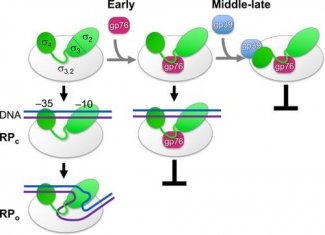Overview
Transcription is the central step, and a major regulatory checkpoint of gene expression. Defective transcription regulation is the common cause of aberrant growth and development and may result in malignant transformation. Transcription is carried out by DNA-dependent RNA polymerases–large, multisubunit molecular machines. Understanding RNA polymerase (RNAP) structure and function is a key to understanding gene expression in molecular detail. The long-term objective of our research is to uncover the molecular basis of transcription mechanism and regulation through structure-functional analysis of bacterial RNAP and associated proteins. In addition, we use bacteriophage development as a model system to study temporal regulation of gene expression and to uncover novel mechanisms of transcription regulation. We also study microcins, small ribosomally-synthesized inhibitors of bacterial growth.
The following research projects were actively pursued during the last year:
Studies of bacteriophage development
Genomic sequences of several novel bacteriophages have been determined and host RNAP binding transcription factors encoded by these phages have been identified. The molecular mechanisms of these factors function, and the structural aspects of their interaction with RNAP have been studied.
Analysis of phage-host interaction has taken a new direction in 2008, concentrating on a novel mechanism of bacterial resistance to phages -- through the action of CRISPR system. CRISPR is a novel system that may be similar to siRNA system in eukaryotes. Our bioinformatic analysis of CRISPR system in plant pathogen X. oryzae have revealed a previously unrecognised degree of diversity of CRISPR machinery in bacteria and showed that CRISPR systems likely target the genomes of infecting phages, not their RNA. Ongoing work on this intriguing system is aimed at elucidation of details of CRISPR genes transcription and of processing of the CRISPR transcript into short RNAs that are required for phage resistance to be manifested.
Structure-functional analysis of RNAP
We continued our studies of various aspects of bacterial RNAP structure and function. The most significant findings included studies of the mechanism of transcription inhibition by antibiotic streptolydigin, elucidation of the mechanism of RNAP stalling when it transcribes through DNA triplexes, and mapping RNAP interaction sites with several transcription factors encoded by novel bacteriophages.
Structure-activity analysis of Microcin C, an inhibitor of translation
Microcin C, a peptide-nucleotide antibiotic, is a potent inhibitor of growth of some Gram-negative bacteria. Microcin C is a Trojan-horse inhibitor: upon entry into sensitive cells microcin C is processed with the release of processed McC -- a modified non-hydrolizable aspartyl-adenylate that inhibits aspartyl-tRNA synthetase. During the last year, improved methods of total synthesis of microcin C analogues have been developed (a collaboration with Dr. Arthur Van Aerschot, Leuven, Belgium) and a series of chemical derivatives of microcin C that target all cellular tRNA synthetases, as well as compounds with varying length of the peptide part of microcin C have been prepared and evaluated. New studies of microcin C resistance uncovered a novel mechanism that involves acetylation of processed microcin C by cellular acetylases of the Rim family.
Studies of bacterial diversity in Antarctica
We are interested in planetary-scale mechanisms responsible for global spread of at least some microbes and their viruses. The ice-covered expanse of Antarctica can be considered as a giant trap for microbes deposited from air due to Aeolian effects. We took part in the 54th and 55-th Russian Antarctic Expeditions and collected large samples of snow from several sites in Antarctica. The samples were melted, concentrated, and are currently being studied by metagenomic and microbiological tool to identify microbes that accumulated on the Antarctic snow surface during the 2009-10 nd 2010-11th seasons.
